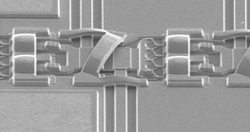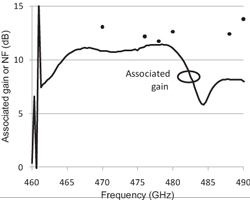
| Home | About Us | Contribute | Bookstore | Advertising | Subscribe for Free NOW! |
| News Archive | Features | Events | Recruitment | Directory |
News
28 May 2010
Frequency record for integrated circuits doubled to 0.67 terahertz
As well as developing terahertz frequency amplifiers for the 0.48THz (480GHz) range and beyond [W.R. Deal et al, IEEE MTT-S International Microwave Symposium Technical Program, session TH1A-2, 2010], researchers at Northrop Grumman Aerospace Systems’ Simon Ramo Microelectronics Center have also achieved a 0.67THz terahertz monolithic integrated circuit (THIC, Figure 1) which, while not presented in the paper, was discussed at the symposium. This performance is claimed to be a new record, more than doubling the frequency of the fastest reported integrated circuit.
 Figure 1: Details of compact 670 GHz circuit layout.
Figure 1: Details of compact 670 GHz circuit layout.
These achievements have been enabled by the development on indium phosphide (InP) transistors with frequency performance characteristics (fT, fmax, etc.) beyond 1THz. These new devices are in the range where it becomes practical to develop amplifiers around the 0.5THz region. The Northrop Grumman researchers have themselves developed InP high-electron-mobility transistors (HEMTs) and heterojunction bipolar transistors (HBT) that operate with fmax values of more than 1THz and 0.62THz, respectively (Table 1).
InP HEMT |
InP HBT |
|||
Technology |
Current-gen |
Next-gen |
Current-gen |
Next-gen |
Feature size |
50nm gate |
30nm gate |
250nm emitter |
150nm emitter |
fT |
0.55THz |
0.69THz (projected) |
0.53THz |
0.64THz (projected) |
fmax |
> 1THz |
> 1.2THz (projected) |
> 0.63THz |
> 1.2THz (projected) |
Highest IC |
0.48THz |
- |
0.32THz |
- |
Table 1: Summary of Northrop Grumman high-frequency transistor performance, both current- and next-generation.
The researchers are seeking various ways to increase their transistor performance values, such as an improved gate process for their sub-50nm HEMTs (Figure 2) and increased current densities to around 30mA/μm2 for their HBTs. The higher current level in the HBT structure will be enabled through a substrate transfer process that will take the HBTs grown on InP and put the device layer onto aluminum nitride, a material with much improved thermal conductivity. Simulations suggest that the device temperature at high current will be reduced by about 40%.
 Figure 2: InP HEMT ~30nm T-gate.
Figure 2: InP HEMT ~30nm T-gate.
These devices have been packaged in various formats. The HEMTs have been used to produce 300GHz and 480GHz low-noise amplifiers. The latter was characterized using the Y-parameter method, giving a measured noise figure of 11.7dB with an associated gain of 11.4dB (Figure 3). Since the minimum noise was achieved at the peak gain of the amplifier, the researchers conclude that gain is limiting the noise performance of the device.
 Figure 3: Measured noise performance of 0.48THz LNA.
Figure 3: Measured noise performance of 0.48THz LNA.
HBT oscillators and single-stage amplifiers have also been produced using thin-film microstrip technology. For example, a 324GHz amplifier has been achieved using a 250nm InP double heterjunction bipolar transistor (DHBT). To reduce the inductance of the ground access, an ‘inverted microstrip’ was used, with the ground metal on top of the benzocyclobutene (BCB) substrate material. RF routing and components are put in the metal-1 layer below the BCB.
The researchers see applications coming from low-noise amplification and local oscillator chains used for radiometry, atmospheric sensing and spectroscopy.
“A variety of applications exist at these frequencies,” comments the paper’s presenter, Dr William Deal, THz Electronics program manager for Northrop Grumman’s Aerospace Systems sector. “These devices could double the bandwidth, or information carrying capacity, for future military communications network,” he adds.” TMIC amplifiers will enable more sensitive radar and produce sensors with highly improved resolution.”
For radar, imaging and communications, the use of transistors rather than the present diode-based systems would increase dynamic range and reduce DC power consumption.
Part of the funding for the research came from the US Defense Advanced Research Projects Agency (DARPA) THz Electronics Program and the Army Research Laboratory.
“ The success of the THz Electronics program will lead to revolutionary applications such as THz imaging systems, sub-mm-wave ultra-wideband ultra-high-capacity communication links, and sub-mm-wave single-chip widely-tunable synthesizers for explosive detection spectroscopy,” says DARPA THz Electronics program manager Dr John Albrecht.
![]() Search: Northrop Grumman Terahertz monolithic integrated circuit InP InP HEMT InP HBT
Search: Northrop Grumman Terahertz monolithic integrated circuit InP InP HEMT InP HBT
Visit: www.as.northropgrumman.com
Visit: www.irconnect.com
Visit: www.mtt-tpms.org
Visit: www.ims2010.org
Visit: www.darpa.mil/mto/programs/thz/index.html
The author Mike Cooke is a freelance technology journalist who has worked in the semiconductor and advanced technology sectors since 1997.